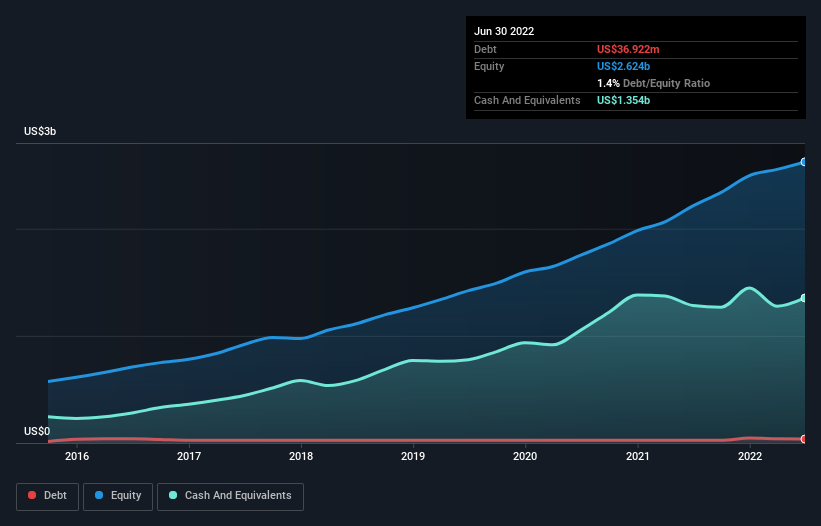EPAM Systems (NYSE:EPAM) Seems To Use Debt Rather Sparingly
David Iben put it well when he said, 'Volatility is not a risk we care about. What we care about is avoiding the permanent loss of capital.' When we think about how risky a company is, we always like to look at its use of debt, since debt overload can lead to ruin. As with many other companies EPAM Systems, Inc. (NYSE:EPAM) makes use of debt. But should shareholders be worried about its use of debt?
Why Does Debt Bring Risk?
Debt is a tool to help businesses grow, but if a business is incapable of paying off its lenders, then it exists at their mercy. In the worst case scenario, a company can go bankrupt if it cannot pay its creditors. However, a more frequent (but still costly) occurrence is where a company must issue shares at bargain-basement prices, permanently diluting shareholders, just to shore up its balance sheet. Having said that, the most common situation is where a company manages its debt reasonably well - and to its own advantage. When we think about a company's use of debt, we first look at cash and debt together.
Check out our latest analysis for EPAM Systems
What Is EPAM Systems's Net Debt?
You can click the graphic below for the historical numbers, but it shows that as of June 2022 EPAM Systems had US$36.9m of debt, an increase on US$25.0m, over one year. However, its balance sheet shows it holds US$1.35b in cash, so it actually has US$1.32b net cash.
A Look At EPAM Systems' Liabilities
According to the last reported balance sheet, EPAM Systems had liabilities of US$684.7m due within 12 months, and liabilities of US$255.3m due beyond 12 months. On the other hand, it had cash of US$1.35b and US$929.2m worth of receivables due within a year. So it can boast US$1.34b more liquid assets than total liabilities.
This short term liquidity is a sign that EPAM Systems could probably pay off its debt with ease, as its balance sheet is far from stretched. Simply put, the fact that EPAM Systems has more cash than debt is arguably a good indication that it can manage its debt safely.
In addition to that, we're happy to report that EPAM Systems has boosted its EBIT by 49%, thus reducing the spectre of future debt repayments. There's no doubt that we learn most about debt from the balance sheet. But it is future earnings, more than anything, that will determine EPAM Systems's ability to maintain a healthy balance sheet going forward. So if you're focused on the future you can check out this free report showing analyst profit forecasts.
But our final consideration is also important, because a company cannot pay debt with paper profits; it needs cold hard cash. EPAM Systems may have net cash on the balance sheet, but it is still interesting to look at how well the business converts its earnings before interest and tax (EBIT) to free cash flow, because that will influence both its need for, and its capacity to manage debt. Over the most recent three years, EPAM Systems recorded free cash flow worth 76% of its EBIT, which is around normal, given free cash flow excludes interest and tax. This free cash flow puts the company in a good position to pay down debt, when appropriate.
Summing Up
While it is always sensible to investigate a company's debt, in this case EPAM Systems has US$1.32b in net cash and a decent-looking balance sheet. And it impressed us with its EBIT growth of 49% over the last year. So we don't think EPAM Systems's use of debt is risky. There's no doubt that we learn most about debt from the balance sheet. But ultimately, every company can contain risks that exist outside of the balance sheet. We've identified 3 warning signs with EPAM Systems , and understanding them should be part of your investment process.
When all is said and done, sometimes its easier to focus on companies that don't even need debt. Readers can access a list of growth stocks with zero net debt 100% free, right now.
Have feedback on this article? Concerned about the content? Get in touch with us directly. Alternatively, email editorial-team (at) simplywallst.com.
This article by Simply Wall St is general in nature. We provide commentary based on historical data and analyst forecasts only using an unbiased methodology and our articles are not intended to be financial advice. It does not constitute a recommendation to buy or sell any stock, and does not take account of your objectives, or your financial situation. We aim to bring you long-term focused analysis driven by fundamental data. Note that our analysis may not factor in the latest price-sensitive company announcements or qualitative material. Simply Wall St has no position in any stocks mentioned.
Join A Paid User Research Session
You’ll receive a US$30 Amazon Gift card for 1 hour of your time while helping us build better investing tools for the individual investors like yourself. Sign up here

